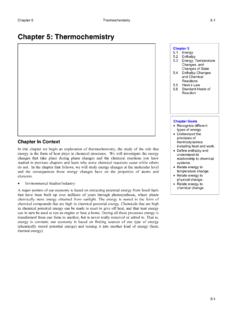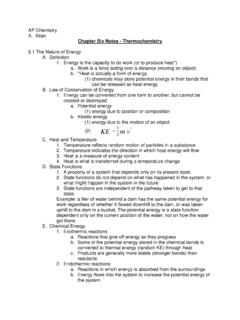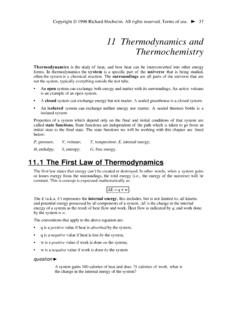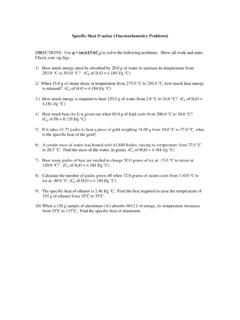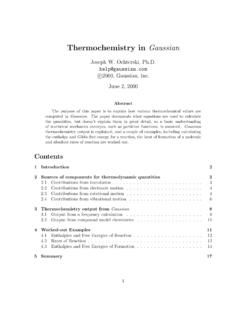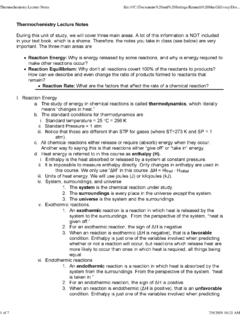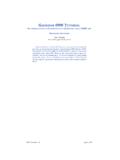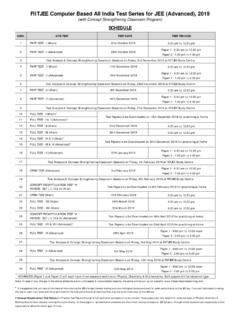Transcription of Chemical reaction hazards and the risk of thermal runaway ...
1 Chemical reaction hazards and the risk of thermal runaway Page 1 of 7 Chemical reaction hazards and the risk of thermal runaway INDG254(rev1) A Chemical reaction that goes out of control and runs away can create a serious Published 08/14 incident with the risk of injury to people and damage to property and the environment. This leaflet: identifies the main hazards of carrying out Chemical reactions ; provides guidance on how you can ensure a safe operation; and identifies some sources of further information and guidance. The advice is aimed at small and medium-sized companies in the Chemical manufacturing industry, although the principles apply equally to all firms. You must assess the risks of your Chemical processes but this does not need to be time-consuming or expensive. You should then ensure that the systems in place reduce the risk of runaway to a level that is as low as reasonably practicable.
2 The effort you take to do this should reflect the complexity of the process and the scale of risks involved. What are Chemical reaction hazards ? Raw materials react together during the manufacture of a Chemical to give the product. Such a Chemical process often releases energy in the form of heat, and the reaction is described as exothermic . A reaction may be exothermic even if you have to heat the reaction mass initially to get the reaction started. This leaflet concentrates on the hazards arising directly from exothermic Chemical reactions . Other hazards associated with Chemical manufacturing those arising from handling toxic or flammable chemicals and general hazards such as noise or working at height are beyond the scope of this leaflet. thermal runaway An exothermic reaction can lead to thermal runaway , which begins when the heat produced by the reaction exceeds the heat removed.
3 The surplus heat raises the temperature of the reaction mass, which causes the rate of reaction to increase. This in turn accelerates the rate of heat production. An approximate rule of thumb suggests that reaction rate and hence the rate of heat generation doubles with every 10 C rise in temperature. Health and Safety Executive Health and Safety Executive Chemical reaction hazards and the risk of thermal runaway Page 2 of 7 thermal runaway can occur because, as the temperature increases, the rate at which heat is removed increases linearly but the rate at which heat is produced increases exponentially. Once control of the reaction is lost, temperature can rise rapidly leaving little time for correction. The reaction vessel may be at risk from over-pressurisation due to violent boiling or rapid gas generation. The elevated temperatures may initiate secondary, more hazardous runaways or decompositions.
4 An over-pressure may result in the plant failing catastrophically resulting in blast or missile damage. A release of flammable materials from the process could result in a fire or an explosion in the workroom. Hot liquors and toxic materials may contaminate the workplace or generate a toxic cloud that may spread off-site. There can be serious risk of injuries, even death, to plant operators, and the general public and the local environment may be harmed. At best, a runaway causes loss and disruption of production, at worst it has the potential for a major accident. Effect of scale The scale on which you carry out a reaction can have a significant effect on the likelihood of runaway . The heat produced increases with the volume of the reaction mixture, whereas the heat removed depends on the surface area available for heat transfer. As scale, and the ratio of volume to surface area, increases, cooling may become inadequate.
5 This has important implications for scale-up of processes from the laboratory to production. You should also consider it when modifying a process to increase the reaction quantities. Causes of incidents Incidents occur because of: inadequate understanding of the process chemistry and thermochemistry; inadequate design for heat removal; inadequate control systems and safety systems; and inadequate operational procedures, including training. These are some of the key factors you should consider in defining a safe process. What do you need to do? To deal with Chemical reaction hazards you first need to identify them. Then you need to decide how likely they are to occur and how serious the consequences would be. This is known as risk assessment. You are required by law to assess the risks that the process presents and, if you have five or more employees, to record the significant findings.
6 Chemical process risk assessment A typical assessment will involve: defining the process, operating conditions and plant; identifying the hazards ; evaluating the risks arising from the hazards and deciding whether existing precautions are adequate or more should be done; Health and Safety Executive Chemical reaction hazards and the risk of thermal runaway Page 3 of 7 selecting and specifying appropriate safety measures; and implementing and maintaining the selected safety measures. You should start the assessment as early as possible during the development of the process. The assessment should identify the potential hazards and investigate their causes. Where possible, hazards should be avoided. As the process design develops, foreseeable deviations from the normal process, such as equipment failure or operator error, should be considered.
7 You may need to follow a structured method for identifying hazards , such as a hazard and operability study (HAZOP), particularly when the plant or processes are highly hazardous, complex or involve new technology. Evaluating reaction hazards To determine the hazards of a reaction , you need information on the chemistry and thermochemistry of the reaction . This includes: the possibility of thermal decomposition of raw materials, intermediates, products and by-products; whether exothermic runaway can occur; and the rate and quantity of heat and gas produced by the reaction . As it is not safe to test unknown reactions in a full-size reactor, various techniques and tests have been developed to provide predictive data. The main methods are: literature data and calculation, to give preliminary information; basic screening tests, such as differential scanning calorimetry or carius tube; isothermal calorimetry (mainly to measure reaction kinetics and heats of reaction ); adiabatic calorimetry (mainly to examine runaways); and relief vent sizing tests.
8 There is no standard procedure that can be followed for all reactions the aim is to obtain the data you need to assess the risk adequately. To avoid undue time and effort, any investigation should reflect the complexity of reaction and the size of the risks involved. Further information on assessing reaction hazards is given in the References at the end of this guidance. Assessment of Chemical reaction hazards , the selection of suitable test methods and the interpretation of results should be carried out by competent, experienced personnel. It may not be cost-effective for a smaller firm to buy specialised test equipment and you may want to use a test house or consultancy. Trade associations and the Institution of Chemical Engineers register can identify consultants familiar with the process and so help in the selection process. Your insurers may also be able to provide technical advice to help you assess your Chemical processes.
9 Safety measures Once you know what the risks are, you can select the measures to ensure safe operation. You can ensure safe operation in a number of ways, by using: inherently safer methods, which eliminate or reduce the hazard; Health and Safety Executive Chemical reaction hazards and the risk of thermal runaway Page 4 of 7 process control, which prevents a runaway reaction occurring; and protective measures, which limit the consequences of a runaway . Inherent safety Where possible, you should first eliminate or reduce hazards by inherently safer design. For example: replace hazardous materials with safer ones: have less unreacted material in the reactor, eg using a continuous process instead of a batch reactor; use a semi-batch method (in which one of the raw materials is added over time) instead of a batch process; and/or use a heating medium which has a maximum temperature that is too low for the reaction mixture to decompose.
10 As the examples suggest, inherently safer methods can fundamentally affect the process it will be easier to use such methods if you consider them in the early stages of process development. Process control Process control includes the use of sensors, alarms, trips and other control systems that either take automatic action or allow for manual intervention to prevent the conditions for uncontrolled reaction occurring. Specifying such measures requires a thorough understanding of the Chemical process involved, especially the limits of safe operation. Protective measures Protective measures do not prevent a runaway but reduce the consequences should one occur. They are rarely used on their own as some preventive measures are normally required to reduce the demand upon them. As they operate once a runaway has started, a detailed knowledge of the reaction under runaway conditions is needed for their effective specification.










